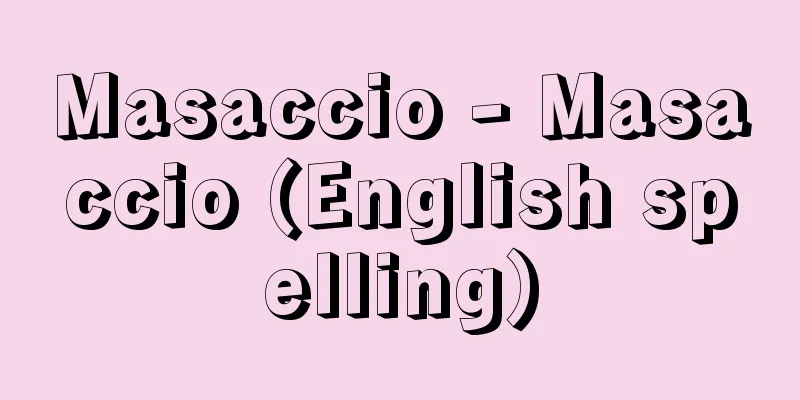Masaccio - Masaccio (English spelling)

|
Italian painter. His real name was Tommaso di Ser Giovanni di Mone. Masaccio was his nickname. He was born in San Giovanni Valdarno, a mountain village in Tuscany. He moved to Florence in 1422 and continued his artistic activities in the city until he went to Rome in 1428, where he died at the age of 27. There are four works that are considered to be his genuine works, and of these, the "Madonna and Child with Saint Anne" (1424-25, Uffizi Gallery), which he painted as an altarpiece for the Basilica of Sant'Ambroggio in Florence, and a series of murals including "The Tribute Money" in the Brancacci Chapel in the Basilica of Santa Maria del Carmine in the same city, were created in collaboration with Masolino. The other two are a triptych for the Basilica of Saint Mary in Pisa, painted in 1826 (now dismantled and held in museums in Pisa, Naples, London, Berlin, and Vienna), and a mural called The Holy Trinity, painted around 1825 for the Basilica of Santa Maria Novella in Florence. Masaccio's role in early Renaissance art was groundbreaking, and he owed much to his contemporaries, the architect Brunelleschi and the sculptor Donatello. He learned perspective from Brunelleschi, which is clearly reflected in "The Holy Trinity," and from Donatello, he learned the rigid, sculptural modeling seen in works such as "Madonna and Child with Saint Anne." His greatest achievement was the introduction of light effects to the depiction of the human body and clothing, and the enhanced color effects that resulted from this became a novel guideline for subsequent painters. In recent years, a theory has been put forward that a triptych of the Madonna and Child with Saints (inscribed with the date of creation, April 23, 1422), discovered in the Basilica of San Giovenale in Cassia, a small village halfway between Florence and his birthplace, is considered to be one of Masaccio's earliest works, and the work itself is housed in the Uffizi Gallery. [Katsuya Hamatani] [References] |Source: Shogakukan Encyclopedia Nipponica About Encyclopedia Nipponica Information | Legend |
|
イタリアの画家。本名Tommaso di Ser Giovanni di Mone。マサッチョは通称。トスカナ地方の山村サン・ジョバンニ・バルダルノ生まれ。1422年フィレンツェに出て、28年にローマに赴くまでこの都市で制作活動を続けるが、この年27歳でローマに没している。彼の真筆として確実視される制作は4か所に残されているが、そのうち、フィレンツェのサン・タンブロッジョ聖堂の祭壇画として描いた『聖母子と聖アンナ』(1424~25・ウフィツィ美術館)と、同市サンタ・マリア・デル・カルミネ聖堂内ブランカッチ礼拝堂に制作した『貢(みつぎ)の銭(ぜに)』を含む一連の壁画は、マソリーノとの共作である。あとの二つは、26年にピサのカルミネ聖堂のための三幅対祭壇画(現在解体されてピサ、ナポリ、ロンドン、ベルリン、ウィーンの各美術館に分散所蔵)と、25年前後にフィレンツェのサンタ・マリア・ノベッラ聖堂に描いた壁画『聖三位(さんみ)一体』である。 初期ルネサンス美術でマサッチョが果たした役割は画期的なものであったが、これには同時代の先達、建築家ブルネレスキと彫刻家ドナテッロに負うところが大きかった。ブルネレスキから学んだ透視図法は『聖三位一体』に端的に反映しているし、ドナテッロからは『聖母子と聖アンナ』などにみられる硬い彫塑的なモデリングを会得している。彼の最大の功績は人体や衣装の表現に光の効果を導入したことで、それによって高められた色彩効果は、その後の画家にとって斬新(ざんしん)な指針となった。なお、フィレンツェと彼の出生地との中間に位置する寒村カッシアのサン・ジョベナーレ聖堂で発見された、聖母子に諸聖者を配した三幅対祭壇画(1422年4月23日と制作時の銘記がある)をマサッチョの最初期の制作とみなす説が近年たてられ、作品自体はウフィツィ美術館に所蔵されている。 [濱谷勝也] [参照項目] |出典 小学館 日本大百科全書(ニッポニカ)日本大百科全書(ニッポニカ)について 情報 | 凡例 |
Recommend
Paysandú (English spelling)
…The river is meandering in the upper reaches, bu...
Anthraquinone pigment - anthraquinone pigment
It is a high-grade organic pigment derived from an...
Public and private insurance - Kohokenshihoken
Insurance can be broadly divided into public and p...
Meigs syndrome
…It is often seen as a partial symptom of general...
Caiman - Kaiman (English spelling) caiman
A general term for crocodiles belonging to the Ca...
Tetraspora lacustris (English spelling)
…[Mitsuo Chihara]. . . *Some of the terminology t...
oily collector
… In addition to the anionic and cationic collect...
Scythians
…the Scythians were a nomadic race of horse rider...
The legend of Umewaka
...A type of Kabuki and Bunraku puppet theater. I...
Ismail Bey (English spelling)
…Official name = Republic of MacedoniaRepublika M...
Wakuya [town] - Wakuya
A town in Toda County in central Miyagi Prefecture...
En passant - En passant
…This special move is only allowed when (a) neith...
Paulet, PA
…These two men are especially highly regarded as ...
Almond, GA - Almond
…The American political scientist D. Easton was t...
Atsuma [town] - Atsuma
A town in Yufutsu County, Hokkaido. It is located ...









